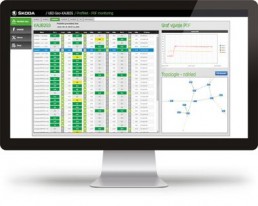What's Next for the Digital Workspace? Make it Intelligent
The digital workspace has become a buzzword that has been widely used (and sometimes misused) by the media and the industry. But does it deserve so much coverage? The short answer is yes.
Many enterprises are deploying ambitious digital transformation strategies to deliver sustained innovation and remain competitive. For them, a digital workspace is instrumental in their digital agenda, and probably the most impactful and empowering set of technologies for their workforce.
The digital workspace essentially enables employees to securely access the right apps and resources to get the job done with speed and ease. Easier said than done. IDC surveys show that securing (and managing) the new workstyles is very much a work in progress and the top Future of Work initiative for advanced digital companies.
These enterprises are becoming borderless — conducting business outside the traditional corporate firewall as they interact with customers and partners and embrace the gig economy. In this respect, implementing a digital workspace, and bringing together their fragmented end-user computing (EUC) environment into a single centralized management model, is vital.
But how to make it work for both IT administrators and employees? How to make it “control freedom”? How to make it intelligent?
The Intelligent Digital Workspace
An intelligent digital workspace, with the right ingredients, can be truly transformational:
- Real-time analytics can provide vital insights about the health of an EUC environment. For example, IT admins can identify assets with patch vulnerabilities.
- Advanced analytics can proactively identify anomalies before they cause work disruption, improving end-user experience. For example, IT admins can stop a new app deployment if an unusual crash error is noticed. Even better, automated remediation can reprovision the app to the last known version that did work.
- Visualizing tools can help with user profiling, optimizing IT assets to the individual needs of employees and generating cost savings.
- Intelligent insights can drive significant operational efficiencies to both IT and employees: the latter (and crucially contractual workers) can be productive from day one; IT administrators can better plan and optimize EUC deployments.
Finally, and most importantly, an intelligent digital workspace can improve the security risk posture of an organization.
While a “zero trust” security approach has been widely adopted today — meaning that devices, apps, and users are not trusted and therefore require verification before privileged access is granted — many companies are implementing intelligent policy automation. Using real-time intelligence, this automatically adjusts access controls depending on the risk score of the logging event.
For example, it can prompt users for further authentication or deny access altogether for a high security risk score event.
A risk-based security policy model can be personalized to employees and evolve throughout their stay with a company. The main objective, after all, is to minimize security risk and reduce insider threats, without getting in the way of business.
In conclusion, an intelligent digital workspace delivers important benefits to different stakeholders across the organization: IT (for operational efficiencies), security (for improved risk posture), finance (for cost savings), HR (for greater end-user experience), and business managers (for higher productivity). Involving all these stakeholders for a holistic approach is crucial for its long-term success.
The industry has plenty of digital workspace solutions, but only a few are truly intelligent and deliver the benefits highlighted above. Do you know their vendors and IT services providers?
Stay tuned and learn more about the digital workspace in the following IDC research program: European Future of Work.
If you’re doing something in this space, contact me at asalmeron@idc.com or head over to https://www.idc.com/eu and drop your details in the form on the top right.
The Changing Role of Enterprise Maintenance in Manufacturing
Much of the manufacturing environment is going through a period of significant disruption — and enterprise asset management is no exception.
Unlike asset-intensive industries, in industries such as automotive, machinery, food and beverage, and pharma there has been a greater focus on reactive and autonomous maintenance for some time. With the emergence of Industry 4.0, maintenance has stepped out of the shadows and many companies have started to assess the newest technologies to help them go beyond a lean and traditional “run to failure and preventive maintenance” approach.
Looking at the digital transformation strategies of leading enterprises, the digitization of asset management has become a priority for many of them. The rapid development of the latest technologies and trends such as edge devices, SaaS-based tools and apps, cloud-based platforms, AI/ML-based models, and digital twins of digital twins has put maintenance engineers, managers, and field workers under even greater pressure, as C-level management seeks to leverage the technology to deliver significantly better operational results. This has resulted in the need for continuous education at all levels in the plant and tighter communication and collaboration with IT vendors and system integrators. Enterprises have also learned from experience that when they relied on a single supplier of a solution the outcome was poor as the solution was so complex that a single vendor was unable to deliver the expected value. In the latest IDC Global IoT Decision Maker Survey 2019 only around 4% of respondents said they had started an IoT project and then failed — highlighting the increasing level of project preparation, including identifying the right project and the right vendor.
Legacy systems are a common challenge for many companies, both on the IT and OT sides. Retrofitting and additional instrumentation could be seen as an easy way out, but in real life this brings other challenges such as placing the sensors in a difficult environment, closed control systems, or unsupported connectivity between the machine (level 1) and the data layer (level 2). This gap would be probably bridged first, when the enterprise invests in new production lines instrumented with the latest generations of controllers that also cover the asset condition monitoring area.
Production Together With Maintenance
Production and maintenance often see each other as process silos, especially when it comes to the utilization of the production data and use of supporting IT systems. Even if modern CMMS systems enable the connection of various systems such as ERP, IIoT, and spare part marketplaces, there are still many enterprises utilizing the CMMS more as a work order management and maintenance planning and scheduling and budgeting tool, ignoring the value the system can bring when properly integrated and used.
On the other hand, the modern way of operations management is based on the ability to oversee the production process holistically through integration of the operational data including asset condition monitoring and energy consumption monitoring. A comprehensive control and visualization solution provides real-time information across production units to the depth of aggregate level. The recommendation management function then distributes information to the right person in real time, providing supportive information to the operators or maintenance people. This approach destroys the traditional siloed way of work through the integration of technology, processes, and organization.
IDC’s point of view: Platforms such as Honeywell’s Forge for Industrial, ABB’s Collaborative Operations Centers utilizing the Ability Platform, and Siemens’ OPCENTER are good examples of how integrated solutions can bring transparency, flexibility, and scalability to complex manufacturing environments.
What Really Helps: Predictive Maintenance vs Condition Monitoring
Predictive maintenance is one of today’s most talked about technologies when speaking about Industry 4.0 and enterprise digitization. But many enterprises confuse predictive maintenance with advanced condition monitoring. Again, condition monitoring’s function is to observe the defined parameters and compare them against defined thresholds (upper and lower limits). Visualization of final outputs is mostly in the form of traffic lights indicating the condition of the machine or aggregated in real time.
Unlike condition monitoring, predictive maintenance is based on the utilization of machine-learning engines, where the current parameters are the basis for the prediction of what will happen in certain periods with certain probability. The cornerstone of success is the prediction accuracy and connection of the predictive model outputs with the enterprise maintenance processes. Deploying predictive maintenance on a fleet of machines is challenging from a cost and technology perspective. In many cases, most companies implement only condition monitoring while believing it is predictive maintenance.
IDC’s point of view: Condition monitoring and predictive maintenance of the complex production assets are still far from “plug and play” solutions. Detailed preparation on customization and final fine-tuning are crucial success factors. Deploy the advanced condition monitoring first and then look to where the predictive models could be deployed. Think about building digital twins of the assets and process and combine data from the asset aggregates, production process, and production environment. Many suppliers have already enhanced their products with digital condition monitoring tools or even digital twins (SKF valves, Siemens and ABB electric motors) that can be used as a foundation of digital twin of digital twins.
Maintenance Worker as a Data Platform
Modern maintenance field workers are equipped with a set of tools that effectively transform them into a fully connected real-time data platform. The data could be acquired through intelligent hardware integrated into the worker’s helmet connected via WiFi, Bluetooth, or the mobile network, utilizing cameras, digital microphones, and sunlight-readable displays for high-resolution photo capture and real-time video chat. The latest technology also provides active remote assistance for workers, geolocalization, navigation, asset visualization, and online library access, among others.
The trend is to provide field workers with full mobility and 24 x 7 remote support. To this end, mobile devices are enhanced with a mobile app for the instrumentation, control systems, and safety systems to view tags, trends, and alarms, and provide access for field staff to all aspects, including workers’ travel to and from production assets located in the field or factory.
Key players in EAM/CMMS are not standing by, and are instead enhancing their applications with remote field support functionalities, providing full data visibility across enterprise systems such as ERP, MES, and PLM, and utilizing data from SCADA systems.
IDC’s point of view: Maintenance field workers become fully connected mobile eyes and ears, and a bridge through which the data flows back and forward among wearable technology, field tools, enterprise asset management solutions, and asset management remote control towers. Deployment of 5G will increase the speed and amount of data that can be transferred between enterprise systems, improving accessibility of the information for field workers. Providing field workers with AR technology still has some way to go, as for many enterprises there is still not a solid business case with a quick return on investment.
Conclusion
Enterprise asset management is going through significant change, and this is having an impact on technology, process, and people. Integrated enterprise systems enable transparency across the production and field network and supply chain, providing huge amounts of data in real time. Though maintenance engineers and field workers are becoming more flexible and effective by having 24 x 7 access to data and information, we should keep in mind that what they really need are clear instructions, guidance, and insights. This really changes roles, from being reactive and almost blind to being able to investigate the immediate future, predict what will happen, and react accordingly.
But it is not just about maintenance. Data engineers and data analysts should also understand the technology and processes that will enable them to turn information into insights, as this is a key success factor when increasing availability and reliability of production assets. Collaboration with data scientists and enterprise maintenance is the real revolution that is driven by rapid technology development.
For more information on this topic, contact us at IDC Manufacturing Insights, or visit Jan Burian’s LinkedIn profile here.
Are You Ready for Agile Learning at Work?
The digital deadlock is affecting many organizations today, big and small, and across all industries. Vast amounts of technology investments are being poured into the engines of aggressive digital strategies — but are delivering little in the way of progress. In fact, many are “stuck in their journey.” What’s holding them back?
IDC has looked into this very closely in the past few years and has found that the “digital skills gap” — when demand for IT skills is not met with adequate supply — is a top obstacle for those organizations in their digital agenda. Interestingly, the challenge is not only in recruitment, but most crucially in bringing up to speed the current workforce with the new skills. Employees are not learning fast enough.
Our surveys show that the impact of the skills gap is broadly felt across the organization, from quality performance to customer satisfaction to business revenue growth. In fact, IDC estimates it will affect 90% of all European companies, resulting in $91 billion in lost revenue in 2020.
The skills gap is now a board-level issue, and employers are determined to tackle the problem themselves by reskilling their own workforce. If colleages and professional schools are not providing an adequate supply of IT professionals, corporate training programs and internal mobility could fill the gap.
This is a significant shift by employers in their training practices and policies. After a decade of austerity following the global financial crisis in 2008, they have now realized that learning means business.
Is the Workforce Ready for the Jobs of the Future? Welcome to Agile Learning
IDC believes agile learning is the way forward for any digital organization because it aligns skills and required training with business value and strategy. It is permanently evolving, keeping pace with new market needs and technology developments.
From content, format, to channels of delivery, agile learning is business relevant while driving superior employee experience.
Agile learning has the following common traits:
- Employee focused: Training needs to be applied to the task and woven into the flow of work (easily digestible). It ultimately has to help employees “get the job done” and achieve better performance (impactful). This could include the consumption of bite-size content (even in minutes), any time and by multiple channels, to fit work demands.
- Business relevant: Training cannot be decided unilaterally by the employee, manager, or HR. It has to be a cross-functional effort to ensure that career development goals and training needs are aligned with business requirements — the right materials, to the right employees, at the right time.
- AI/ML enabled: Training can be enhanced by intelligent technologies in multiple ways. AI/ML can help employees by providing career pathway recommendations; for employers, it can identify training that addresses the skills gap. In the not-so-distant future, intelligent technologies will be able to measure the impact of training on performance and business outcomes, helping to make it business relevant.
Agile learning will be ingrained in our work culture moving forward, helping us to become more competent in our jobs (upskilling) or even to move into new jobs (reskilling). It can also prepare us for the new jobs of the future, those that have not even be created yet. In this respect, IDC expects micro-degrees to become increasingly popular.
Micro-degrees can be useful to equip employees, reasonably quickly, for new jobs such as a flying car developer or an algorithm bias auditor. Developed in partnership with academia, industry, and employers, micro-degrees complement lectures with on-the-job training.
Agile learning affects us all. As the retirement age rises, we should be able to expect significant mobility throughout our careers. Agile learning will be part of a lifelong learning work culture, mandated by the C-suite and instilled into the organization.
To quote the World Economic Forum’s Future of Jobs Report 2018, “By 2025, 75 million current jobs will be displaced by the shift in the division of labour between humans, machines and algorithms, but 133 million new jobs will be created as well.”
Your current job might be one of those 75 million. Act now to enjoy the Future of Work with the other 133 million.
Are you ready for the jobs of the future?
If you’re doing something in this space, contact me at asalmeron@idc.com or head over to https://www.idc.com/eu and drop your details in the form on the top right.
Learn more about this and related topics in the following IDC research programs:
European Skills: Leadership and Capabilities for Digital Transformation






